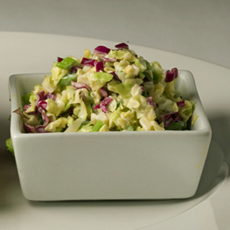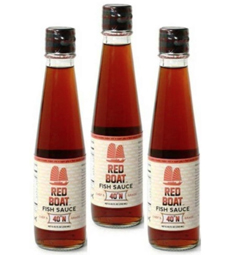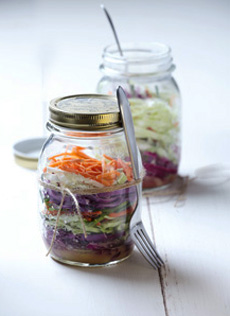Vietnamese Cabbage Slaw, a.k.a. Cole Slaw, Recipe
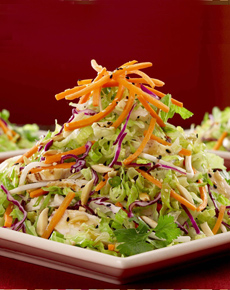 [1] Vietnamese slaw, made with a fish sauce-accented vinaigrette (photo © The Cheesecake Factory.
|
So many slaws, so little time! On summer weekends, we try different slaw recipes and different potato salads. When made without mayonnaise, cole slaw is a very low-calorie food, and cabbage is an antioxidant-packed cruciferous vegetable. That’s what you’ll find in the Asian-style slaw recipe below. Today’s tip also highlights a relatively unfamiliar ingredient to Americans, fish sauce. But first: Long a part of the culinary repertoire, “koolsla,” short for “koolsalade,” means cabbage salad in Dutch; Dutch travelers to the New World made the dish with local cabbage. Instead of being torn into bite-size pieces like lettuce salad, the cabbage was thinly sliced or shredded. Cabbage, the “kool,” is pronounced “cole.” “Sla” is short for “salade.” The term got anglicized in the 18th century as cole slaw (and sometimes, cold slaw). In English, “slaw” came to specify a salad of shredded vegetables. Over time, shredded cabbage slaw was joined by carrot slaw and more recently, broccoli slaw and shaved Brussels sprouts slaw. Called nam pla in Thai and nuoc mam (“salted fish water”) in Vietnamese, fish sauce is an amber-hued condiment prepared from fermented anchovies and salt. An umami flavor lauded as “the fifth taste” after sweet, sour, bitter, and salty, fish sauce is a major ingredient and condiment in Thai and Vietnamese cuisine. Numerous brands are imported to the U.S., including Red Boat Fish Sauce. Fish sauce provides a flavor known as umami, often explained as savory or brothy. We consume “umami foods” every day: anchovy paste, asparagus, beef stew, bouillon, cured ham, ketchup, lamb shank, miso sauce and soup, MSG, mushrooms, Parmesan cheese, ripe and sun-dried tomatoes, soy sauce, steak sauce and Worcestershire sauce, among others. Umami and fish sauce are also part of Western culture. Beginning in Greece and appearing in nearly every ancient Roman recipe as early as the 7th and 8th centuries B.C.E., garum, a fermented fish sauce, was the universal condiment used to add flavor to food. As ketchup (and more lately, hot sauce) is to American fare, as soy sauce is to Chinese cuisine, the favorite condiment in ancient Rome was garum, an anchovy sauce. It involved into colatura di alici, juice of anchovies, still popular in Italy. It’s also called anchovy sauce or anchovy syrup; the latter is inaccurate, as a syrup is a thick, viscous liquid. As strange as “anchovy juice” may sound, colatura is an aromatic condiment that enhances any dish, adding flavor without fuss. |
|
|
Ask any great Italian chef, and you’ll probably find that colatura di alibi is their secret ingredient. Chef Lidia Bastianich uses a touch of colatura instead of salt. Colatura (the word comes from the Latin colare, to strain) is made by curing anchovies with salt and extracting the free-run liquid that drains from them. It’s a laborious and painstaking process to create a truly artisan food. Different brands are imported from Italy. Things came full circle in the 19th century when British sea captain Henry Lewis Edwardes (1788–1866) brought the recipe for a fish sauce condiment home after travels in India. It somehow got to John Wheeley Lea and William Henry Perrins, two dispensing chemists (pharmacists) in Worcester, England, who created the first “umami sauce” (Worcestershire Sauce) sold commercially in England, in 1837. Here are more uses for fish sauce, colatura di alici, or whatever you choose to call it. |
||
|
RECIPE: VIETNAMESE CABBAGE SLAW This recipe was created by Gail Simmons for Pure Leaf Tea. She pairs it with Sweet Honey Green Pure Leaf. We paired it with Unsweetened Green and Unsweetened Lemon Flavor Pure Leaf. Ingredients For 4 Servings For The Dressing 1. MAKE the dressing so the shallots have time to marinate. Whisk the ingredients except the shallots in a large mixing bowl. Then add the shallots and set aside. 2. FINELY SLICE the cabbages, radishes, and cucumbers using a mandolin or a food processor with the slicer and grater attachments. Grate the carrots and separate the cilantro leaves. |
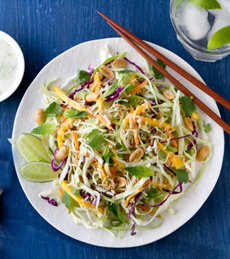
|
|
|
3. CORE the apples and finely slice them into thin half–moons. Place everything into the mixing bowl with the dressing and toss together well. When ready to serve, top with the peanuts and extra cilantro leaves. MORE SLAW RECIPES CHECK OUT WHAT’S HAPPENING ON OUR HOME PAGE, THENIBBLE.COM. |
||
